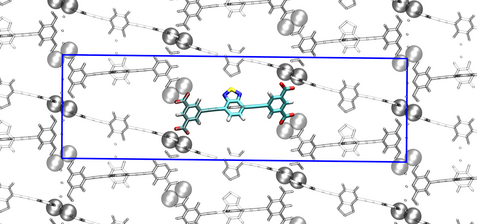Thin MOF films with photoswitchable electronic properties and On-Off conductance
Conductivity • MOF Loading • Field Response
H. Oberhofer,(a) D. Volkmer,(b) A. Wixforth (c)
(a) Chair for Theoretical Chemistry, Department of Chemistry, Technical University Munich, 80748 Garching
(b) Chair of Solid State and Materials Chemistry, Institute of Physics, University of Augsburg, 86159 Augsburg
(c) Chair for Experimental Physics I, Institute of Physics, University of Augsburg, 86159 Augsburg
One of the main research targets of the MOF@SAW consortium is the properties of metal organic frameworks (MOF) under applied electric fields for use in such diverse applications as sensing or gas separation. Thereby, a high degree of control over a wide range of field strengths is afforded by the surface acoustic wave (SAW) chips used in the project, allowing us high accuracy measurements of elastic properties or conductivities of the MOF in the SAW-induced fields. In our contribution we will discuss two properties. First, predicted theoretically and later confirmed experimentally, we show a dependence of the conductivity of iron(II) (1,2,3) triazolate (Fe(ta)2) on the loading of its pores with chemically inert gas molecules. Using a modified Bardeen-Shockley model(1,2) we show that the main contributor to the increase of the conductivity with loading is the change in the deformation potential, essentially a measure for the electron-phonon interaction. We discuss a number of pitfalls for comparing experimental and theoretical results, such as the non-trivial problem of relating experimental and theoretical gauges for MOF pore loading. Overall, our findings represent an important step towards a MOF@SAW trace gas sensing device.
In the second part of our presentation we report on the progress of our efforts to (theoretically and experimentally) design novel field actuated MOFs(3) for use in gas separation. We present theoretical results of the rotational barrier of groups with high dipole moments incorporated into the linkers of Zn2(btadpa). Using a simple Ising model, parametrized from first principles, we show the non-vanishing interaction of these linkers and their response to the applied electric field.
References
(1) C. Muschielok, H. Oberhofer, Aspects of Semiconductivity in Soft, Porous Metal-Organic Crystals, J. Chem. Phys. 2019, 151, 015102.
(2) H. Oberhofer, K. Reuter, J. Blumberger, Charge Transport in Molecular Materials: An Assessment of Computational Methods, Chem. Rev. 2017, 117, 10319
(3) A. Knebel, B. Geppert, K. Volgmann, D. I. Kolokolov, A. G. Stepanov, J. Twiefel, P. Heitjans, D. Volkmer, and J. Caro. "Defibrillation of soft porous metal-organic frameworks with electric fields." Science 2017, 358, 347.
Interested in finding out more? Click here to learn more about this overarching COORNETs Phase II team and project.
